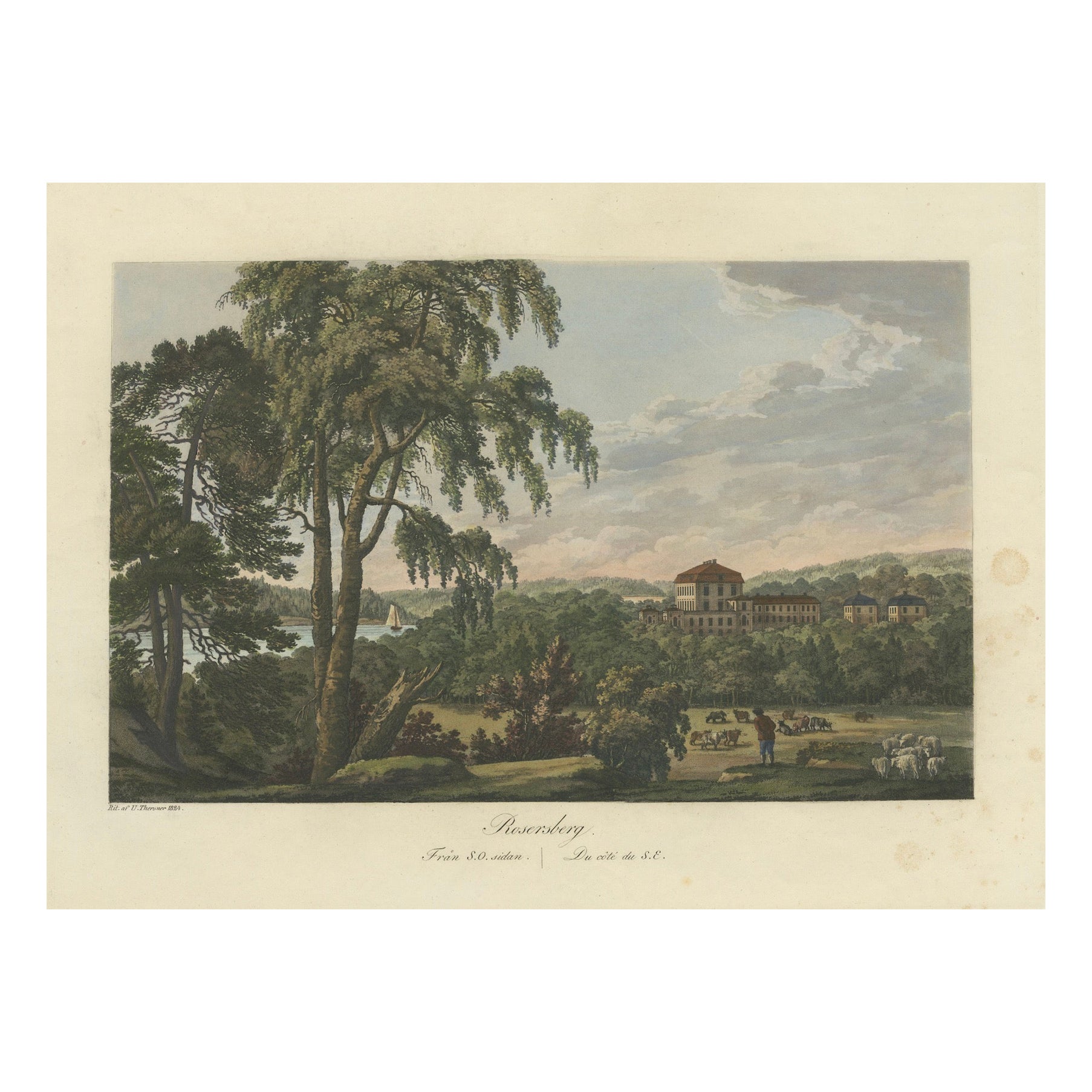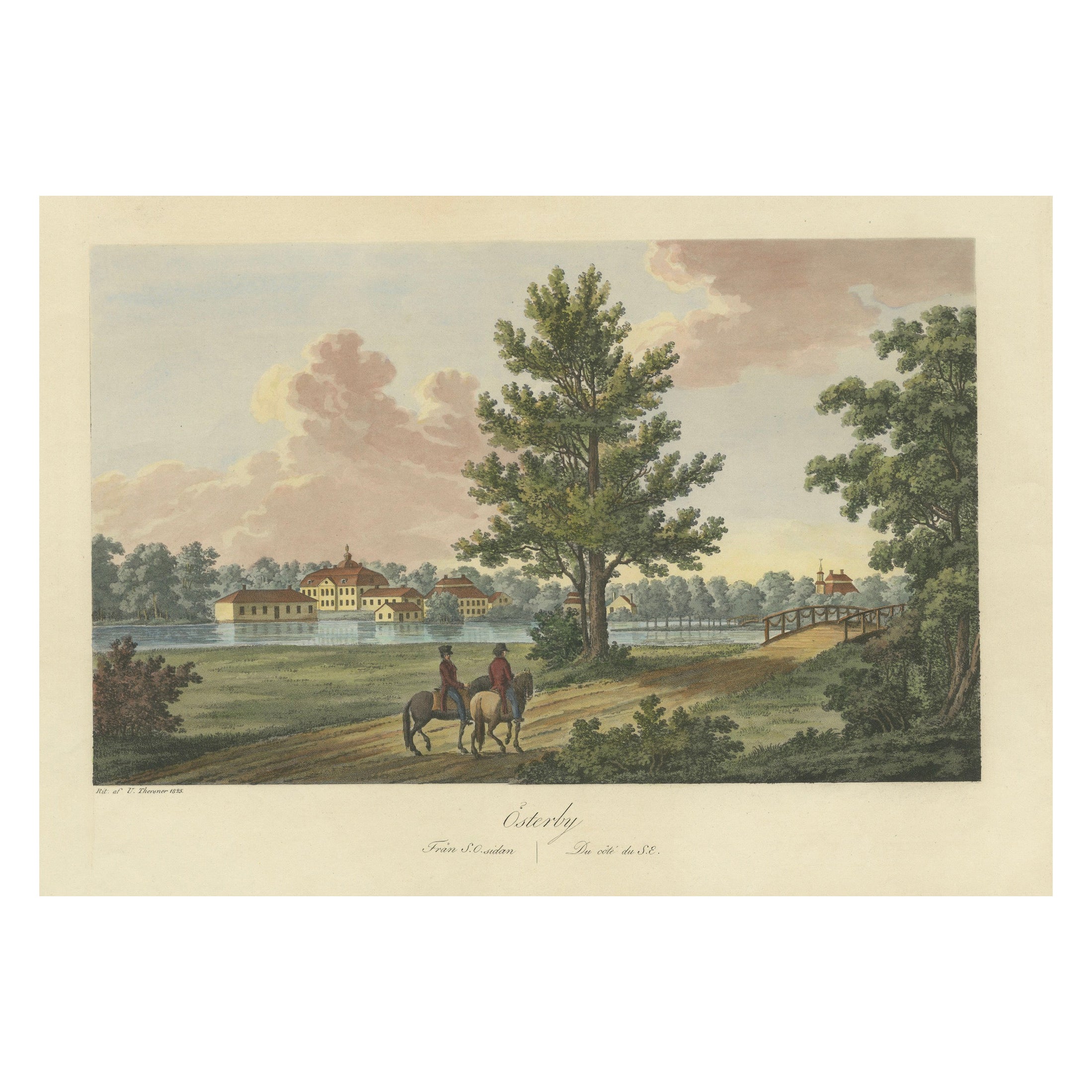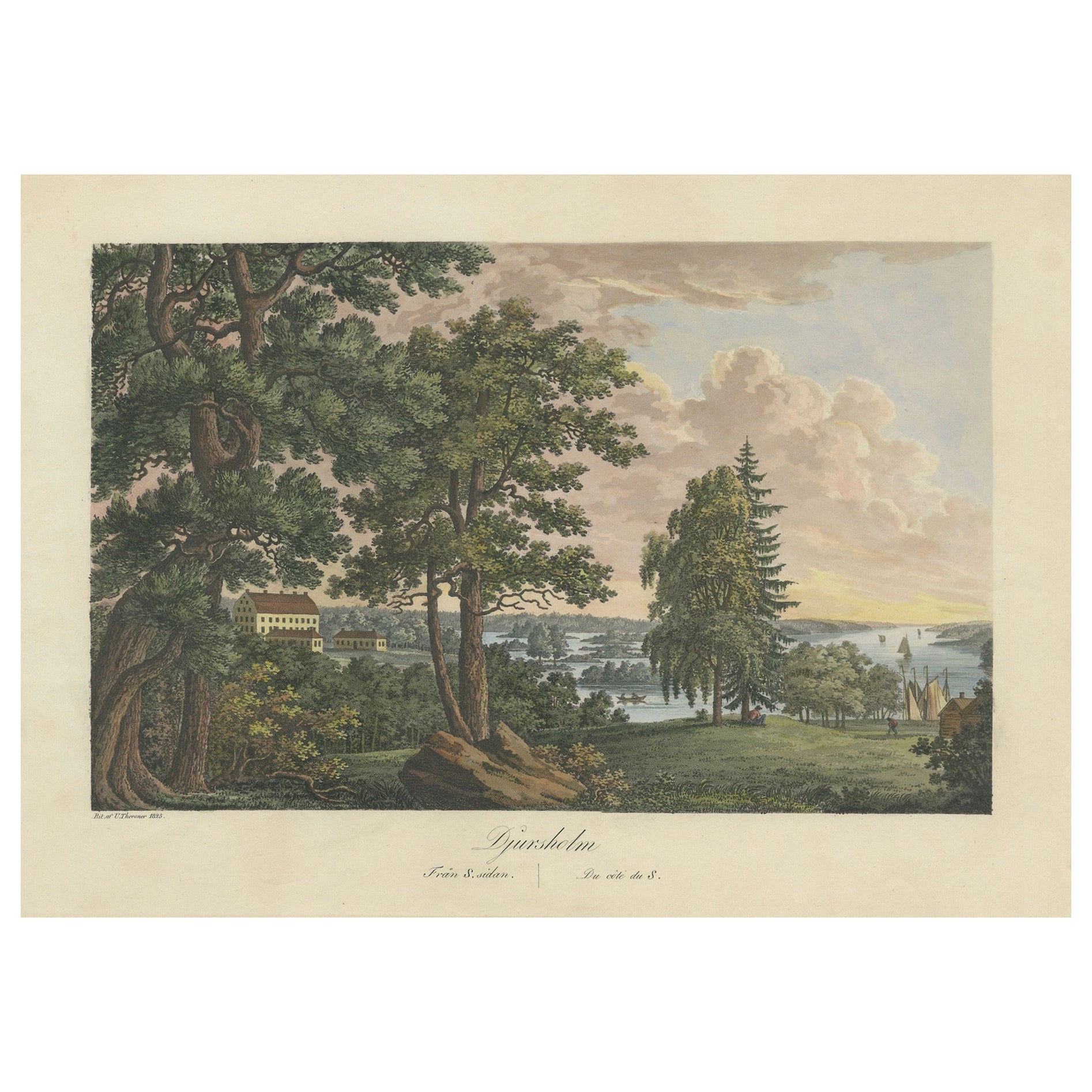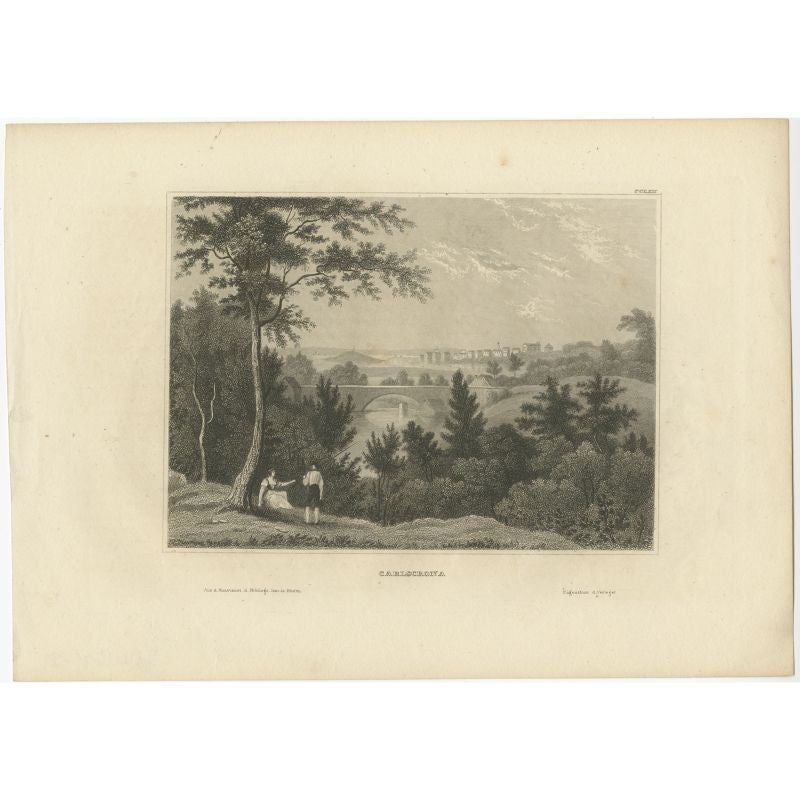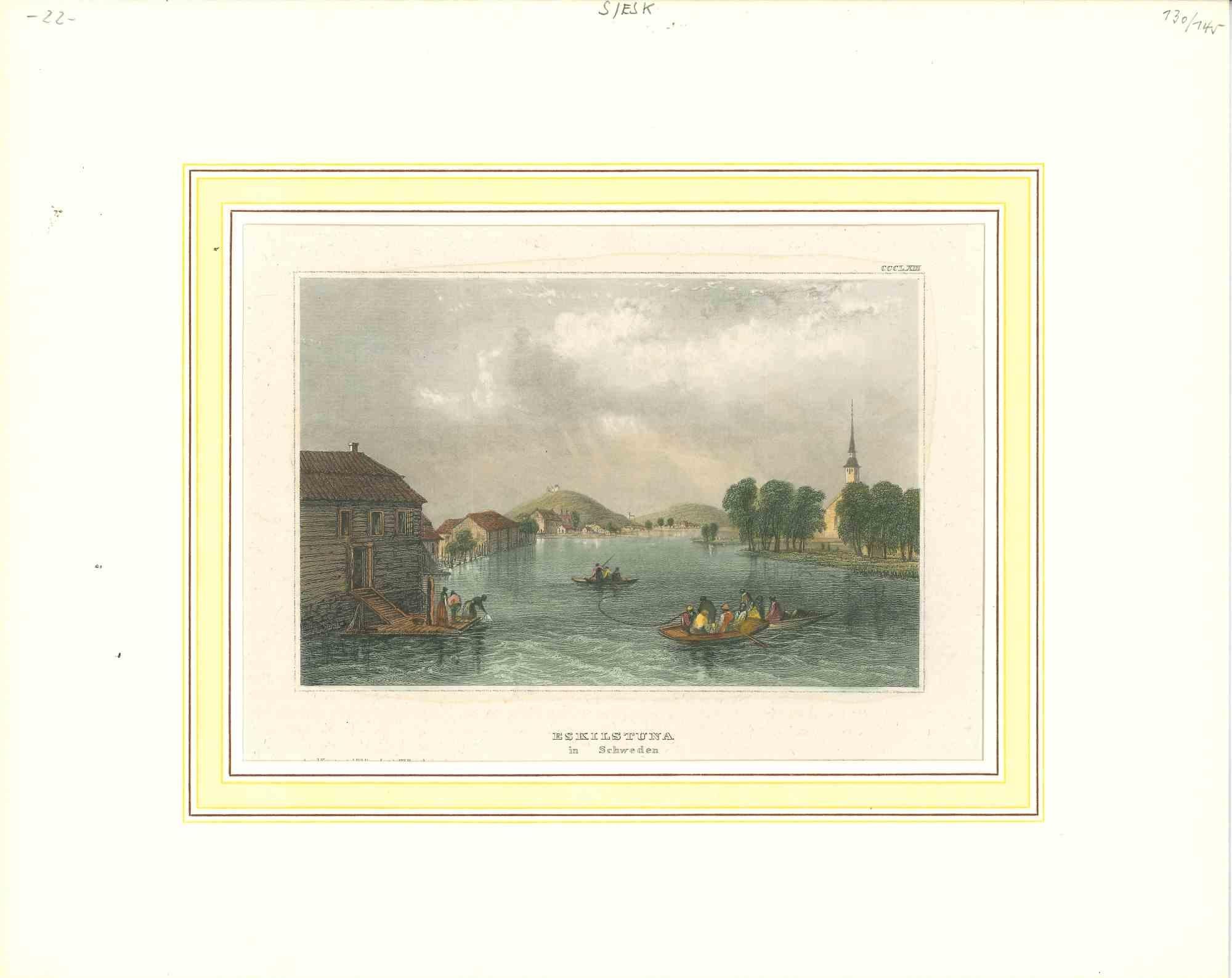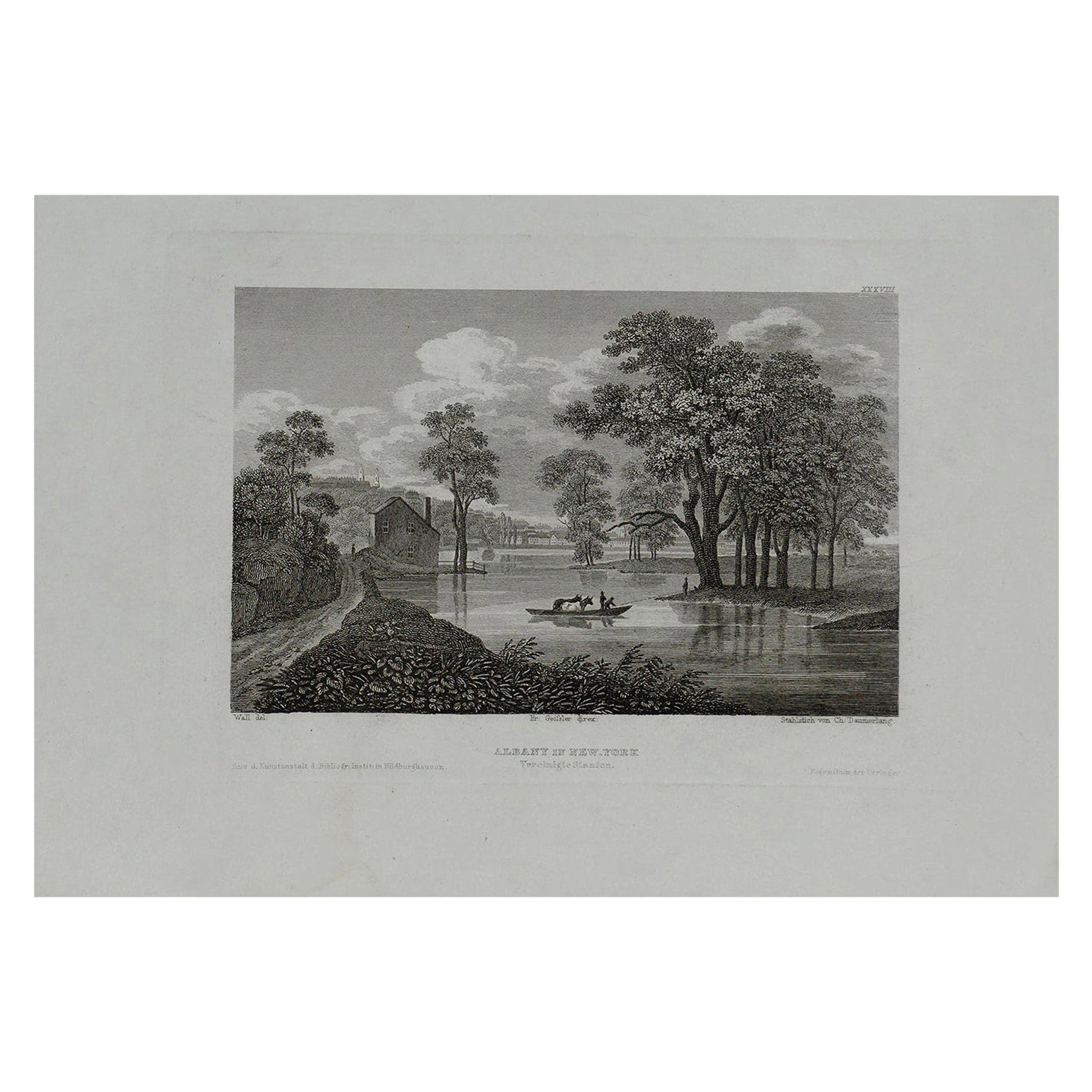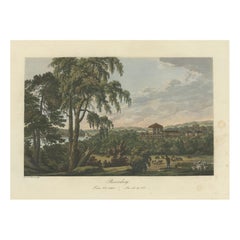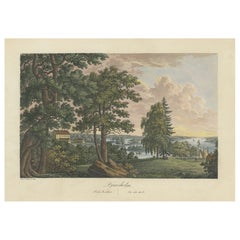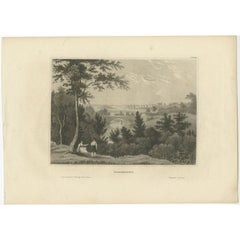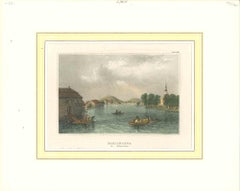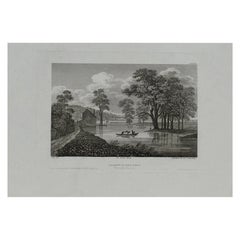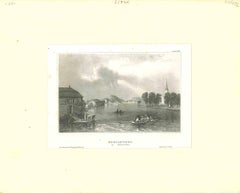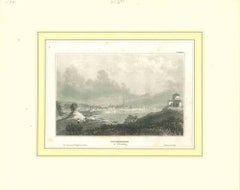Items Similar to Bucolic Tranquility: Söderfors in Sweden by Ulrik Thersner, 1825
Want more images or videos?
Request additional images or videos from the seller
1 of 7
Bucolic Tranquility: Söderfors in Sweden by Ulrik Thersner, 1825
$542.86
$678.5720% Off
£403.49
£504.3720% Off
€456
€57020% Off
CA$749.54
CA$936.9220% Off
A$831.18
A$1,038.9820% Off
CHF 436.73
CHF 545.9120% Off
MX$10,155.66
MX$12,694.5820% Off
NOK 5,464.03
NOK 6,830.0420% Off
SEK 5,128.93
SEK 6,411.1620% Off
DKK 3,472.21
DKK 4,340.2620% Off
About the Item
This original antique aquatint is a picturesque depiction of Söderfors, a place likely to be in Sweden, given the naming convention and style of the artwork. Crafted by Ulrik Thersner in 1825, the image portrays a vibrant, pastoral scene set by a rushing waterway, suggesting the presence of a river or stream. The landscape is dotted with buildings that have the architectural hallmarks of early 19th-century Swedish design. A group of figures is depicted in the foreground, which adds a human element and scale to the scene.
Söderfors, if it is the same location known today, has a historical industrial background and is located in Uppsala County, Sweden. The area has been known for its ironworks and manufacturing history dating back to the 17th century. It is a locality situated in Tierp Municipality, Uppsala County, Sweden with 1,572 inhabitants in 2010
If the aquatint represents this area, it may have captured Söderfors at a time when it was transitioning from a more agricultural society to one influenced by industrialization. Today, the region may still have remnants of its historical past, although it would have undoubtedly undergone significant changes since Thersner's time.
More about the maker:
Ulrik Thersner was a multifaceted individual, having an impactful military career alongside his work as a draftsman and topographer. Born on April 2, 1779, in Kyrkslätt parish in Finland, Thersner began his military service early, becoming a ship's boy in the Swedish navy at the tender age of seven. His naval service during Gustav III's Russian War marked the beginning of a lifelong commitment to the military.
In 1794, he advanced to the rank of sergeant in the Army's fleet and was appointed as an ensign five years later. His career took a significant turn in 1804 when he was appointed information officer at the Gothenburg squadron, a role that involved hydrographic measurements in Bohuslän.
Thersner's military engagements were diverse and geographically spread; in 1807, he transitioned to the Field Survey Corps, where he became a lieutenant in 1808. His expertise in surveying was put to use during the Finnish War, where he was involved in operations in Åland and battles at Sävar and Ratan. By 1810, Thersner had risen to the rank of captain and contributed to the border delineation between Sweden and Russia.
His membership in the Royal Academy of Military Sciences in 1811 further affirmed his academic and professional stature. During the war of 1813-14, Thersner held various commands and notably led the engineering efforts during the siege of Glückstadt.
Promoted to major in the Field Survey Brigade in 1814, Thersner post-war undertook triangulation measurements in Skåne from 1815 to 1817, demonstrating his proficiency in the practical applications of surveying and mapping. His retirement came in 1825, when he left the service with the rank of lieutenant colonel.
Beyond his military service, Thersner is most renowned for his authorship of "Fordna och närvarande Sverige" (Antiquity and Present Sweden), a work that illustrated Swedish estates and landscapes, reflecting both his artistic talent and his technical skills as a surveyor and cartographer. Thersner's artistic endeavors served as a historical record and a tribute to Sweden's cultural and geographic landscapes.
Thersner's life came to an end on September 2, 1828, in Västerås, Sweden. His dual legacy as a dedicated military officer and as an artist who meticulously recorded Sweden's geographical beauty ensures his enduring place in Swedish history.
- Dimensions:Height: 15.75 in (40 cm)Width: 21.26 in (54 cm)Depth: 0 in (0.02 mm)
- Materials and Techniques:
- Period:
- Date of Manufacture:1825
- Condition:Good. Some soiling and light brown spots, mostly our of the plate mark and not in the image itself. Outer edge on the lower right a wrinkle. Please study the images carefully.
- Seller Location:Langweer, NL
- Reference Number:Seller: Bg-13670-311stDibs: LU3054338099462
About the Seller
5.0
Recognized Seller
These prestigious sellers are industry leaders and represent the highest echelon for item quality and design.
Platinum Seller
Premium sellers with a 4.7+ rating and 24-hour response times
Established in 2009
1stDibs seller since 2017
2,609 sales on 1stDibs
Typical response time: <1 hour
- ShippingRetrieving quote...Shipping from: Langweer, Netherlands
- Return Policy
Authenticity Guarantee
In the unlikely event there’s an issue with an item’s authenticity, contact us within 1 year for a full refund. DetailsMoney-Back Guarantee
If your item is not as described, is damaged in transit, or does not arrive, contact us within 7 days for a full refund. Details24-Hour Cancellation
You have a 24-hour grace period in which to reconsider your purchase, with no questions asked.Vetted Professional Sellers
Our world-class sellers must adhere to strict standards for service and quality, maintaining the integrity of our listings.Price-Match Guarantee
If you find that a seller listed the same item for a lower price elsewhere, we’ll match it.Trusted Global Delivery
Our best-in-class carrier network provides specialized shipping options worldwide, including custom delivery.More From This Seller
View AllPastoral Elegance: Ulrik Thersner's 1824 Aquatint of Djursholm Castle
Located in Langweer, NL
This beautiful original hand-colored antique print, made by Ulrik Thersner in 1824, is a fine example of his work. Thersner, known for his detailed and atmospheric landscapes, would have drawn this view of Djursholm Castle with great care, capturing not only the architectural features of the castle but also the surrounding natural landscape and pastoral life, as seen in the foreground with figures and livestock.
The aquatint technique allowed Thersner to produce gradations of tone that give the print a remarkable depth and a lifelike quality, a characteristic that was particularly prized in the early 19th century for the way it mimicked the subtleties of watercolor paintings.
The composition of the print, with the castle situated amidst the verdant trees and the inclusion of human and animal figures, creates a harmonious balance between the built environment and the natural world, reflecting the romantic sensibilities of the time. The view "from the S.E. angle" provides a unique perspective of the castle, emphasizing its prominence and setting within the landscape.
As a historical document, the print serves as a valuable visual record of Djursholm Castle and its environs in the early 1800s. As an artwork, it stands as a testament to Thersner's skill as an artist and his contribution to the tradition of Swedish topographical art.
More about the maker:
Ulrik Thersner was a multifaceted individual, having an impactful military career alongside his work as a draftsman and topographer. Born on April 2, 1779, in Kyrkslätt parish in Finland, Thersner began his military service early, becoming a ship's boy in the Swedish navy at the tender age of seven. His naval service during Gustav III's Russian War...
Category
Antique 1820s Prints
Materials
Paper
$426 Sale Price
34% Off
Free Shipping
Gentle Repose at Österby: An 1824 Aquatint by Ulrik Thersner
Located in Langweer, NL
Gentle Repose at Österby: An 1824 Aquatint by Ulrik Thersner.
This aquatint by Ulrik Thersner, created in 1824, depicts the serene landscape of Österby in Sweden. The image is suffused with a gentle light that bathes the scene in a warm, inviting glow. It features two individuals on horseback in the foreground, suggesting a tranquil pace of life and leisurely exploration. Their presence adds a narrative element to the scene, inviting viewers to contemplate the journey the riders are undertaking.
The central focus of the aquatint is the stately building situated by the water, likely a manor house or a significant estate of the time, reflecting the architectural style of the early 19th century. The estate is flanked by expansive, lush greenery and tall trees, with a prominent pine tree in the foreground that anchors the composition. The detailed rendering of the foliage and the atmospheric perspective in the background create a sense of depth and spaciousness.
In Skåne, Thersner had drawn several mansions in 1816, and he decided to publish a counterpart to Erik Dahlbergh's Suecia antiqua et hodierna. He called his work Fordna och present Sverige, and in 1817 began its publication. Carl Fredrik Akrell engraved the images, which were executed in aquatint. Eventually, Wilhelm Maximilian Carpelan joined the publication. The Scania part was completed in 1823, Östergötland was started in 1820 and Uppland and Södermanland in 1824-25. Thersner himself wrote the text for the pictures.
After Thersner's death, his widow, with the help of friends, continued the publication, which had never received public support. Michael Gustaf Anckarsvärd took over the publication, in lithographic form, until 1843. The work could be continued, partly with the drawings left by Thersner as templates, partly by Anckarsvärd and others contributing new drawings. In general, Anckarsvärd's work is considered superior to Thersner's. In 1843, the work was taken over by Thersner's daughter, Thora Thersner (1818-1867). She continued publishing until her death. Thora Thersner lithographed her drawings herself, which are usually considered conscientious, if somewhat dry and weak. During her time, among other things, the part about Närke (1838-55) was continued and completed. At the time of Thora Thersner's death, the entire work comprised 91 booklets, containing 364 plates with text. The publication had cost each subscriber 682 kroner and 50 öre.
More about the maker:
Ulrik Thersner was a multifaceted individual, having an impactful military career alongside his work as a draftsman and topographer. Born on April 2, 1779, in Kyrkslätt parish in Finland, Thersner began his military service early, becoming a ship's boy in the Swedish navy at the tender age of seven. His naval service during Gustav III's Russian War...
Category
Antique 1820s Prints
Materials
Paper
Swedish Grace and Grandeur: The Aquatint Legacy of Ulrik Thersner, 1825
Located in Langweer, NL
This hand-colored aquatint is a topographical view of Djursholm Castle in Danderyd, Sweden, and it is a part of Ulrik Thersner's ambitious project, "Fordna och närvarande Sverige" (Antiquity and Present Sweden). This work aimed to be a modern counterpart to Erik Dahlbergh's "Suecia antiqua et hodierna," a significant 17th-century work that showcased Sweden's historical and contemporary landscapes, buildings, and monuments through engravings.
Ulrik Thersner's endeavor in creating "Fordna och närvarande Sverige" involved drawing several mansions, among other subjects, and began publishing these works in 1817. The technique used, aquatint, is a form of etching that allows for the creation of images with tonal variations, resembling watercolor paintings, which makes it particularly suited for detailed and atmospheric topographical representations like the one of Djursholm Castle.
Carl Fredrik Akrell, a notable engraver, worked on engraving Thersner's images, which were then executed in aquatint, a process that allows for a rich gradation of tones and a painterly quality. Wilhelm Maximilian Carpelan later joined the publication effort, indicating a collaborative process in bringing Thersner's vision to fruition.
The parts of the series were published over a period, with Skåne completed in 1823, and the regions of Östergötland, Uppland, and Södermanland addressed in the years 1820 and 1824-25. Thersner's personal involvement in writing the text for the pictures underlines the detailed and scholarly approach taken in producing this series.
Thersner's "Fordna och närvarande Sverige" would have been an invaluable contribution to the documentation of Swedish cultural heritage and landscape during the early 19th century, providing a vivid pictorial record that would have appealed to both the scholarly community and the general public interested in the country's history and geography. The print of Djursholm Castle that you are referring to would be a part of this important series.
More about the maker:
Ulrik Thersner was a multifaceted individual, having an impactful military career alongside his work as a draftsman and topographer. Born on April 2, 1779, in Kyrkslätt parish in Finland, Thersner began his military service early, becoming a ship's boy in the Swedish navy at the tender age of seven. His naval service during Gustav III's Russian War...
Category
Antique 1820s Prints
Materials
Paper
$647 Sale Price
20% Off
Free Shipping
Antique Print of Karlskrona in Sweden, 1839
Located in Langweer, NL
Antique print titled 'Carlscrona'. View of Karlskrona, Sweden. Originates from 'Meyers Universum'.
Artists and Engravers: Joseph Meyer (May 9, 1796 - June 27, 1856) was a German i...
Category
Antique 19th Century Prints
Materials
Paper
$114 Sale Price
20% Off
Old Print of View of Bray on Thames in the County of Berkshire, England, ca.1834
Located in Langweer, NL
Description: Antique print titled 'Bray, Bucks'. View of Bray, occasionally Bray on Thames, is a large suburban village and civil parish in the English county of Berkshire. This print originates from 'Tombleson's Thames' by William Gray...
Category
Antique 1830s Prints
Materials
Paper
$152 Sale Price
20% Off
A Dahlberg View in Sweden from 'Suecia Antiqua et Hodierna', 1693
Located in Langweer, NL
Title: "Maritime Elegance: A Dahlberg View from 'Suecia Antiqua et Hodierna'"
Description: This captivating hand-colored copper engraving is a piece from "Suecia Antiqua et Hodierna...
Category
Antique Late 17th Century Prints
Materials
Paper
$276 Sale Price
20% Off
Free Shipping
You May Also Like
Ancient View of Eskilstuna - Original Lithograph - Mid-19th Century
Located in Roma, IT
Ancient View of Eskilstuna is an original modern artwork realized in Germany in the Mid-19th Century.
Original Colored Lithograph on Ivory Paper.
Inscripted on the lower central m...
Category
Mid-19th Century Modern Figurative Prints
Materials
Lithograph
Original Antique Print of Albany, New York, circa 1840
Located in St Annes, Lancashire
Great print of Albany, New York
Steel engraving by Daumerlang after Wall
Published circa 1840
Unframed.
Category
Antique 1840s German Other Prints
Materials
Paper
Ancient View of Eskilstuna - Original Lithograph - Mid-19th Century
Located in Roma, IT
Ancient View of Eskilstuna is an original modern artwork realized in Germany in the Mid-19th Century.
Original B/W Lithograph on Ivory Paper.
Inscripted on the lower central margi...
Category
Mid-19th Century Modern Figurative Prints
Materials
Lithograph
Ancient View of Gothenburg - Original Lithograph - Mid-19th Century
Located in Roma, IT
Ancient View of Gothenburg is an original modern artwork realized in Germany in the Mid-19th Century.
Original B/W Lithograph on Ivory Paper.
Inscripted on the lower central margi...
Category
Mid-19th Century Modern Figurative Prints
Materials
Lithograph
Ancient View of Stockholm - Original Lithograph - Mid-19th Century
Located in Roma, IT
Ancient View of Stockholm is an original modern artwork realized in Germany in the Mid-19th Century.
Original B/W Lithograph on Ivory Paper.
Inscripted on the lower central margin...
Category
Mid-19th Century Modern Figurative Prints
Materials
Lithograph
Original Antique Print of Albany, New York. 1837
Located in St Annes, Lancashire
Great print of Albany
Steel engraving after W.H Bartlett
Published by Virtue 1837
Unframed.
The measurement is the paper size.
Free shipping
Category
Antique 1830s English Other Prints
Materials
Paper
More Ways To Browse
Antique Egg Collection
Antique Egyptian Doors
Antique Fire Guard Screen
Antique Flat Files
Antique French Clock With Garnitures
Antique French Music Box
Antique French Sevres Porcelain Inkwells
Antique French Slate Clock
Antique French Wood Statues
Antique Fukagawa Vase
Antique Furniture With Secret Compartments
Antique Glass Hinged Box
Antique Grandmothers Clock
Antique Hand Carved Wooden Chest
Antique Honey Pot
Antique Horn Snuff Box
Antique Indian Oil Lamp
Antique Jade Dragon
